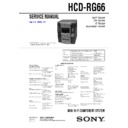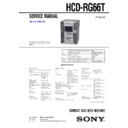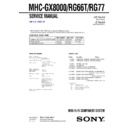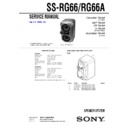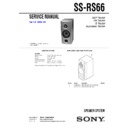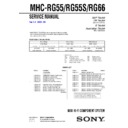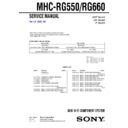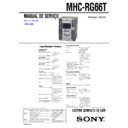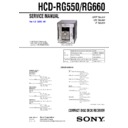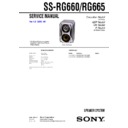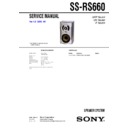Read Sony HCD-RG66 / MHC-RG66 Service Manual online
HCD-RG66
AEP Model
UK Model
E Model
Australian model
SERVICE MANUAL
MINI HI-FI COMPONENT SYSTEM
Sony Corporation
Home Audio Company
Published by Sony Engineering Corporation
Published by Sony Engineering Corporation
9-873-972-02
2003K16-1
© 2003.11
• HCD-RG66 is the tuner, deck, CD and
amplifier section in MHC-RG66.
SPECIFICATIONS
Ver 1.1 2003. 11
Model Name Using Similar Mechanism
NEW
CD
CD Mechanism Type
CDM58F-K6A
Section
Optical Pick-up Name
KSM-213D
Tape deck
Model Name Using Similar Mechanism
NEW
Section
Tape Transport Mechanism Type
CWL43RR-51
Amplifier section
AEP and UK models:
AEP and UK models:
DIN power output (rated)
115 + 115 watts (6 ohms
at 1 kHz, DIN)
at 1 kHz, DIN)
Continuous RMS power output (reference)
140 + 140 watts (6 ohms
at 1 kHz, 10% THD)
at 1 kHz, 10% THD)
Music power output (reference)
280 + 280 watts (6 ohms
at 1 kHz, 10% THD)
at 1 kHz, 10% THD)
Singapore and Australian models:
The following measured at AC 120, 220, 230 –
240 V, 50/60 Hz
DIN power output (rated) 115 + 115 watts (6 ohms
240 V, 50/60 Hz
DIN power output (rated) 115 + 115 watts (6 ohms
at 1 kHz, DIN)
Continuous RMS power output (reference)
140 + 140 watts (6 ohms
at 1 kHz, 10% THD)
at 1 kHz, 10% THD)
Inputs
MD/VIDEO (AUDIO) IN (phono jacks):
MD/VIDEO (AUDIO) IN (phono jacks):
voltage 450/250 mV,
impedance 47 kilohms
impedance 47 kilohms
GAME (AUDIO) IN (phono jack):
voltage 450 mV,
impedance 47 kilohms
impedance 47 kilohms
MIC (phone jack) (except for European models):
sensitivity 1 mV,
impedance 10 kilohms
impedance 10 kilohms
Outputs
PHONES (stereo mini jack):
PHONES (stereo mini jack):
accepts headphones of
8 ohms or more
8 ohms or more
Front speaker:
accepts impedance of 6 to
16 ohms
16 ohms
Surround speaker:
accepts impedance of
24 ohms
24 ohms
CD player section
System
Compact disc and digital
audio system
audio system
Laser
Semiconductor laser
(
(
λ
=780 nm)
Emission duration:
continuous
continuous
Frequency response
2 Hz – 20 kHz (
±
0.5 dB)
Wavelength
780 – 790 nm
Signal-to-noise ratio
More than 90 dB
Dynamic range
More than 90 dB
CD OPTICAL DIGITAL OUT
(Square optical connector jack, rear panel)
Wavelength
(Square optical connector jack, rear panel)
Wavelength
660 nm
Output Level
–18 dBm
Tape deck section
Recording system
4-track 2-channel stereo
Frequency response
50 – 13,000 Hz (
±
3 dB),
using Sony TYPE I
cassette
cassette
Tuner section
FM stereo, FM/AM superheterodyne tuner
FM tuner section
Tuning range 87.5 – 108.0 MHz
Antenna FM lead antenna
Antenna terminals 75 ohm unbalanced
Intermediate frequency 10.7 MHz
Antenna FM lead antenna
Antenna terminals 75 ohm unbalanced
Intermediate frequency 10.7 MHz
AM tuner section
Tuning range
European and Middle Eastern models:
European and Middle Eastern models:
531 – 1,602 kHz (with the
interval set at 9 kHz)
interval set at 9 kHz)
Other models:
531 – 1,602 kHz (with the
interval set at 9 kHz)
530 – 1,710 kHz (with the
interval set at 10 kHz)
interval set at 9 kHz)
530 – 1,710 kHz (with the
interval set at 10 kHz)
Antenna
AM loop antenna
Antenna terminals
External antenna terminal
Intermediate frequency
450 kHz
General
Power requirements
AEP and UK models:
AEP and UK models:
230 V AC, 50/60 Hz
Australian model:
230 – 240 V AC, 50/
60 Hz
60 Hz
Singapore model:
120 V, 220 V or 230 –
240 V AC, 50/60 Hz
Adjustable with voltage
selector
240 V AC, 50/60 Hz
Adjustable with voltage
selector
Power consumption
AEP and UK models:
AEP and UK models:
220 watts
0.5 watts (at the Power
Saving Mode)
0.5 watts (at the Power
Saving Mode)
Singapore and Australian models:
220 watts
Dimensions (w/h/d)
Approx. 280
×
325
×
421 mm
Mass
Approx. 10.5 kg
Supplied accessories:
AM loop antenna (1)
Remote Commander (1)
Batteries (2)
FM lead antenna (1)
Front speaker pads (8)
Remote Commander (1)
Batteries (2)
FM lead antenna (1)
Front speaker pads (8)
Design and specifications are subject to change
without notice.
without notice.
2
HCD-RG66
1. GENERAL
·········································································· 3
2. DISASSEMBLY
································································ 5
2-1. Case (Top) ····································································· 5
2-2. CD Door ········································································ 6
2-3. Front Panel Section ······················································· 6
2-4. CD Mechanism Deck (CDM58F-K6A) ························ 7
2-5. Tape Mechanism Deck (CWL43RR-51) ······················ 7
2-6. MIC Board, PANEL Board, REM Board ····················· 8
2-7. KEYBOARD Board ····················································· 8
2-8. Back Panel Section ······················································· 9
2-9. SUB TRANS Board, VIDEO OUT Board,
2-2. CD Door ········································································ 6
2-3. Front Panel Section ······················································· 6
2-4. CD Mechanism Deck (CDM58F-K6A) ························ 7
2-5. Tape Mechanism Deck (CWL43RR-51) ······················ 7
2-6. MIC Board, PANEL Board, REM Board ····················· 8
2-7. KEYBOARD Board ····················································· 8
2-8. Back Panel Section ······················································· 9
2-9. SUB TRANS Board, VIDEO OUT Board,
SENSOR Board, SURROUND Board ·························· 9
2-10. MAIN Board ······························································· 10
2-11. POWER Board ···························································· 10
2-12. TRANS Board ···························································· 11
2-13. BD Board, DRIVER Board ········································ 11
2-14. SPDL MORTR Board ················································ 12
2-15. Optical Pick-up (KSM-213D) ····································· 12
2-16. MOTOR Board, ADDRESS SENSOR Board ············ 13
2-17. Table (New), Cam (Control) and DC Motor ··············· 13
2-11. POWER Board ···························································· 10
2-12. TRANS Board ···························································· 11
2-13. BD Board, DRIVER Board ········································ 11
2-14. SPDL MORTR Board ················································ 12
2-15. Optical Pick-up (KSM-213D) ····································· 12
2-16. MOTOR Board, ADDRESS SENSOR Board ············ 13
2-17. Table (New), Cam (Control) and DC Motor ··············· 13
3. TEST MODE
···································································· 14
4. ELECTRICAL ADJUSTMENTS
······························· 16
5. DIAGRAMS
······································································ 18
5-1. Circuit Boards Location ·············································· 19
5-1. Circuit Boards Location ·············································· 19
5-2. Block Diagrams –TUNER Section– ··························· 20
5-2. Block Diagrams –TUNER Section– ··························· 20
MAIN Section ····························································· 21
5-3. Printed Wiring Boards – CD Section (1/2) – ·············· 22
5-4. Printed Wiring Boards – CD Section (2/2) – ·············· 23
5-5. Schematic Diagram – CD Section – ··························· 24
5-6. Printed Wiring Board – MAIN Section – ··················· 25
5-7. Schematic Diagram – MAIN Section (1/4) – ············· 26
5-8. Schematic Diagram – MAIN Section (2/4) – ············· 27
5-9. Schematic Diagram – MAIN Section (3/4) – ············· 28
5-10. Schematic Diagram – MAIN Section (4/4) – ············· 29
5-11. Printed Wiring Boards – PANEL Section – ················ 30
5-12. Schematic Diagram – PANEL Section – ···················· 31
5-13. Printed Wiring Boards – POWER/TRANS Section – 32
5-14. Schematic Diagram – POWER/TRANS Section – ····· 33
5-15. Printed Wiring Board
5-4. Printed Wiring Boards – CD Section (2/2) – ·············· 23
5-5. Schematic Diagram – CD Section – ··························· 24
5-6. Printed Wiring Board – MAIN Section – ··················· 25
5-7. Schematic Diagram – MAIN Section (1/4) – ············· 26
5-8. Schematic Diagram – MAIN Section (2/4) – ············· 27
5-9. Schematic Diagram – MAIN Section (3/4) – ············· 28
5-10. Schematic Diagram – MAIN Section (4/4) – ············· 29
5-11. Printed Wiring Boards – PANEL Section – ················ 30
5-12. Schematic Diagram – PANEL Section – ···················· 31
5-13. Printed Wiring Boards – POWER/TRANS Section – 32
5-14. Schematic Diagram – POWER/TRANS Section – ····· 33
5-15. Printed Wiring Board
– SURROUND/KEYBOARD Section – ···················· 34
5-16. Schematic Diagram
– SURROUND/KEYBOARD Section – ···················· 34
5-17. IC PIN FUNCTION DESCRIPTION ························· 38
6. EXPLODED VIEWS
······················································ 40
6-1. Main Section ······························································· 40
6-2. Front Panel Section ····················································· 41
6-3. MAIN Board Section ·················································· 42
6-4. CD Mechanism Deck Section (CDM58F-K6A) ········· 43
6-2. Front Panel Section ····················································· 41
6-3. MAIN Board Section ·················································· 42
6-4. CD Mechanism Deck Section (CDM58F-K6A) ········· 43
7. ELECTRICAL PARTS LIST
······································· 44
SAFETY-RELATED COMPONENT WARNING!!
COMPONENTS IDENTIFIED BY MARK
0
OR DOTTED LINE WITH
MARK
0
ON THE SCHEMATIC DIAGRAMS AND IN THE PARTS
LIST ARE CRITICAL TO SAFE OPERATION. REPLACE THESE
COMPONENTS WITH SONY PARTS WHOSE PART NUMBERS
APPEAR AS SHOWN IN THIS MANUAL OR IN SUPPLEMENTS
PUBLISHED BY SONY.
COMPONENTS WITH SONY PARTS WHOSE PART NUMBERS
APPEAR AS SHOWN IN THIS MANUAL OR IN SUPPLEMENTS
PUBLISHED BY SONY.
This appliance is classified as a CLASS 1 LASER product. The
CLASS 1 LASER PRODUCT MARKING is located on the rear
exterior.
CLASS 1 LASER PRODUCT MARKING is located on the rear
exterior.
Laser component in this product is capable
of emitting radiation exceeding the limit for
Class 1.
of emitting radiation exceeding the limit for
Class 1.
CAUTION
Use of controls or adjustments or performance of procedures
other than those specified herein may result in hazardous radiation
exposure.
other than those specified herein may result in hazardous radiation
exposure.
Notes on chip component replacement
• Never reuse a disconnected chip component.
• Notice that the minus side of a tantalum capacitor may be
• Notice that the minus side of a tantalum capacitor may be
damaged by heat.
Flexible Circuit Board Repairing
• Keep the temperature of soldering iron around 270˚C
during repairing.
• Do not touch the soldering iron on the same conductor of the
circuit board (within 3 times).
• Be careful not to apply force on the conductor when soldering
or unsoldering.
NOTES ON HANDLING THE OPTICAL PICK-UP
BLOCK OR BASE UNIT
BLOCK OR BASE UNIT
The laser diode in the optical pick-up block may suffer electrostatic
break-down because of the potential difference generated by the
charged electrostatic load, etc. on clothing and the human body.
During repair, pay attention to electrostatic break-down and also
use the procedure in the printed matter which is included in the
repair parts.
The flexible board is easily damaged and should be handled with
care.
break-down because of the potential difference generated by the
charged electrostatic load, etc. on clothing and the human body.
During repair, pay attention to electrostatic break-down and also
use the procedure in the printed matter which is included in the
repair parts.
The flexible board is easily damaged and should be handled with
care.
NOTES ON LASER DIODE EMISSION CHECK
The laser beam on this model is concentrated so as to be focused on
the disc reflective surface by the objective lens in the optical pick-
up block. Therefore, when checking the laser diode emission,
observe from more than 30 cm away from the objective lens.
the disc reflective surface by the objective lens in the optical pick-
up block. Therefore, when checking the laser diode emission,
observe from more than 30 cm away from the objective lens.
TABLE OF CONTENTS
Ver 1.1 2003.11
3
HCD-RG66
This section is extracted
from instruction manual.
from instruction manual.
SECTION 1
GENERAL
Main unit
ALPHABETICAL ORDER
A – G
AUDIO jacks wh (29)
CD es (12, 13, 19, 20)
CD SYNC qj (19, 20)
Deck A wd (17, 18)
Deck B qh (17 – 21, 26)
DIRECTION 6 (18 – 20, 26)
DISC 1 – 3 0 (12, 13, 20)
DISC SKIP/EX-CHANGE qa (11,
CD es (12, 13, 19, 20)
CD SYNC qj (19, 20)
Deck A wd (17, 18)
Deck B qh (17 – 21, 26)
DIRECTION 6 (18 – 20, 26)
DISC 1 – 3 0 (12, 13, 20)
DISC SKIP/EX-CHANGE qa (11,
12)
Disc tray 9 (11)
DISPLAY 6 (17, 24)
EDIT 6 (20)
EFFECT ON/OFF 3 (22)
ENTER qs (11, 13 – 15, 20, 23,
DISPLAY 6 (17, 24)
EDIT 6 (20)
EFFECT ON/OFF 3 (22)
ENTER qs (11, 13 – 15, 20, 23,
27, 28)
FM MODE 6 (16)
GAME wk (25)
GAME EQ wa (22)
GAME MIXING ws (25)
GROOVE 2 (22)
GAME wk (25)
GAME EQ wa (22)
GAME MIXING ws (25)
GROOVE 2 (22)
M – Z
MD (VIDEO) wl (30)
MIC jack*
MIC jack*
1
wg (26)
MIC LEVEL control*
1
wg (26)
MOVIE EQ 7 (22)
MUSIC EQ 4 (22)
P FILE ql (23)
PHONES jack qf
PLAY MODE 6 (12, 13, 20)
REC PAUSE/START qk (19, 20,
MUSIC EQ 4 (22)
P FILE ql (23)
PHONES jack qf
PLAY MODE 6 (12, 13, 20)
REC PAUSE/START qk (19, 20,
26)
REPEAT 6 (12)
SPECTRUM 6 (25)
SURROUND SPEAKER
SPECTRUM 6 (25)
SURROUND SPEAKER
MODE 8 (21)
TAPE A/B e; (17, 19)
TUNER MEMORY 6 (14, 15)
TUNER/BAND
TUNER MEMORY 6 (14, 15)
TUNER/BAND
R
R
ea (14 – 16, 19)
VIDEO jack wj (29)
VOLUME control qd
VOLUME control qd
BUTTON DESCRIPTIONS
?/1 (power) 1
v/V/b/B 5
Z OPEN/CLOSE qa
Z (deck B) qg
M w;
v/V/b/B 5
Z OPEN/CLOSE qa
Z (deck B) qg
M w;
. w;
x w;
hH w;
X w;
> w;
m w;
Z (deck A) wf
*
1
Except for European models
1
2345
6
78
9
0
qd
qs
qf
qg
qh
qj
qk
ql
qa
w;
wa
ws
wd
wf
wg
wj
wh
wk
e;
wl
ea
es
4
HCD-RG66
Remote Control
ALPHABETICAL ORDER
A – G
CD qj (12, 13, 19, 20)
CLEAR 6 (13)
CLOCK/TIMER SELECT 2
CLEAR 6 (13)
CLOCK/TIMER SELECT 2
(21, 28)
CLOCK/TIMER SET 3 (11, 20,
27)
D.SKIP ql (12)
EFFECT ON/OFF qa (22)
ENTER qf (11, 13 – 15, 20, 23,
EFFECT ON/OFF qa (22)
ENTER qf (11, 13 – 15, 20, 23,
27, 28)
GAME qk (25)
M – Z
MD (VIDEO) 9 (30)
P FILE qd (23)
PRESET +/– 5 (14 – 16)
PRESET EQ qg (22)
SLEEP 1 (27)
SURROUND 0 (23)
TAPE A/B 8 (17, 19)
TUNER/BAND qh (14 – 16, 19)
TUNING +/– 5 (14 – 16)
VOL +/– 7
P FILE qd (23)
PRESET +/– 5 (14 – 16)
PRESET EQ qg (22)
SLEEP 1 (27)
SURROUND 0 (23)
TAPE A/B 8 (17, 19)
TUNER/BAND qh (14 – 16, 19)
TUNING +/– 5 (14 – 16)
VOL +/– 7
BUTTON DESCRIPTIONS
?/1 (power) 4
M 5
M 5
. 5
x 5
nN 5
X 5
> 5
m 5
v/V/b/B qs
5
6
7
8
9
0
qa
qs
1 2 3 4
qd
qf
qg
qh
ql
qk
qj
Setting the clock
1
Press
?/1
to turn on the system.
2
Press CLOCK/TIMER SET on the
remote.
remote.
3
Press
v
or
V
repeatedly to set the hour.
4
Press
B
.
The minute indication flashes.
5
Press
v
or
V
repeatedly to set the
minute.
6
Press ENTER.
The clock starts working.
To adjust the clock
1
Press CLOCK/TIMER SET on the remote.
2
Press
v
or
V
repeatedly to select “CLOCK
SET”, then press ENTER.
3
Do the same procedures as step 3 to 6
above.
above.
Note
The clock settings are canceled when you disconnect
the power cord or if a power failure occurs.
the power cord or if a power failure occurs.

